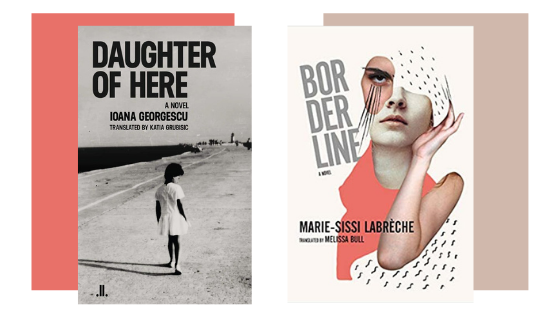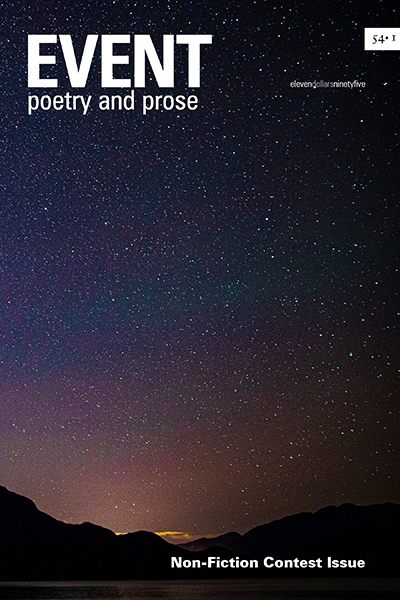Véronique Darwin Reviews Translation By Melissa Bull and Katia Grubisic for EVENT 50/2

Véronique Darwin Reviews:
Marie-Sissi Labrèche, Trans. Melissa Bull, Borderline, Anvil Press, 2020
Ioana Georgescu, Trans. Katia Grubisic, Daughter of Here, Linda Leith
Publishing, 2020
Autofiction is the genre of quasi-memoir created when a first-person narrator rearranges the material of their life into a novel. Vivid detail reigns over plot. Scenes are told in the passing, fragmented way of someone trying to make sense of a life while still living it. Even if the protagonist is presented as a character, we assume the writer’s lived experience. How else could such a complex life be so loosely held? This assumption is heightened when the book’s project is visible: In autofiction, we often witness the narrator composing the book we’re reading. Jumps in time reflect the working of the mind as it spins the tale. Autofiction fascinates me because, in some multiple-mirror way, the degree of separation created by the protagonist seems to bring the reader even more intimately into the writer’s voice, as though by trying to gain distance through fiction, the writer has actually exposed themselves—or something that feels like a self—from a truer angle. As readers of autofiction, we witness not only the unravelling of a life but also the rewrapping of its pieces into a novel.
In the case of Borderline, a Québécois novel written by Marie-Sissi Labrèche in 2000 and translated by Melissa Bull in 2020, the protagonist Sissi aims to gain control of a life in which she’s had none. ‘I’ve got a problem with limits,’ says Sissi, who has been diagnosed with borderline personality disorder. ‘I can’t tell the difference between inside and out.’ The book creates these limits through chapters within which Sissi battles for control over difficult childhood memories. She uses caustic humour and shocking detail to plant us firmly in the second-grade classroom where she and her classmates witness a meltdown by her mother, who has schizophrenia, or in the hospital, where ‘we were going to go see my mother. Or maybe [my grandmother] said that we would see if I was like my mother or against my mother?’ All sections are written in the present tense, with the voice and knowledge of the 24-year-old narrator. Though Sissi is biting—it’s jarring to hear an eight-year-old refer to her grandmother as ‘the old fuck,’ or use the phrase ‘take on a tragic air’ to announce her mother’s suicide attempt—we understand she is biting back. Using humour as both a form of avoidance and a way of digging into her past, Sissi experiences an emotional catharsis, and we are witness to her therapeutic process.
The 2013 novel La jetée, elle s’appellera Mo by fellow Montreal writer Ioana Georgescu was also translated from the French, by Katia Grubisic, in 2020 as Daughter of Here. Unlike Borderline, this novel has no claim to autofiction, yet it also uses detail (in this case lush and sensorial, rather than humorous and cutting) and a present-tense immediacy to jump in time and place, mimicking the texture of a life recalled. Without Sissi’s fervent energy and clear project of self-discovery, Dolores weaves together far more than her own experiences. She is a collector, a dreamer, remembering to pass the time. Georgescu is inspired by the French 1962 experimental film La jetée by Chris Marker, in which still images and an offscreen narrator recount a futuristic memory experiment. ‘The man,’ otherwise undefined, has his eyes covered and is forced by scientists to remember potential past memories. Without concern for chronology, Dolores also presents the past in images: a bar in Tokyo during an earthquake; the confluence of the White and Blue Nile where she met her partner Célestin; and her childhood escape and adolescent return to Bucharest behind the Iron Curtain. Perhaps more like the scientists than ‘The Man,’ Dolores is a filmmaker. She employs history and other people’s stories artfully to fill out her own. Unlike Sissi, Dolores does so for an audience. While Dolores stands at the window in an apartment in Cairo, her young daughter Mo, addressed in the second-person ‘you,’ zips around on her scooter or draws the scenes described. As readers, we feel soothed, peering with Mo over Dolores’s shoulder through the window of her story.
Both Sissi and Dolores are artist-protagonists who have turned to themselves as subjects, building their own history through fragments—emotionally interior in Sissi’s case and sensorially exterior in Dolores’s. Labrèche and Bull move toward beauty with rich metaphors, but hold back, leaving the reader uncomfortably raw and writhing in Sissi’s distress. As the child Sissi ‘traumatizes’ her classmates by drawing a pair of sad blue eyes, the adult Sissi muses on the weather: ‘When it rains, during the day, the light is beautiful on my skin. It looks like I’m shimmering. It looks like I’m warm. Like I got fucked and I got hot. It’s been a week since I fucked anyone.’ The harsh language, reflecting the consistent turmoil of Sissi’s experiences, can be grating, but there is a lightness through which we are able to engage with the emotion of each moment. Despite the use of a glossary for certain cultural references, we sense the humour is not always for us, but rather Sissi’s way of walking herself into her memories and limping back out of them.
Dolores uses several metaphors for her project in Daughter of Here: she is telling her life story as mathematics—‘curly brackets, square, round’—or as the trucks her daughter plays with, ‘going back, forward, back,’ or, most frequently, as a film reel or photo album: ‘I scan bits of the film of my life, before Mo, and after.’ While gorgeous and imaginal, the fragmented scenes distance us from Dolores. The cinematic novel floats from unexplained airport bench scene to minor character backstory without always grounding us in her emotional memory. Why, for example, in one of the penultimate chapters, do we need to learn of ‘the schoolteacher who taught Mia, my friend Daria’s sister’? A long dreamscape sequence, a possible future involving an apocalypse of tomatoes, appears in the place a reader might expect a climax. This is most clearly where the two novels diverge: While Sissi is bringing her pieces together, Dolores is content to let them fall where they may.
Doubling is a theme in both novels, perhaps reflecting the narrators’ (and writers’) self-awareness. ‘I divide myself in two,’ Sissi explains: ‘one part is pretending, while the other hides and trembles.’ Sleeping with a new friend Saffie when her boyfriend is out of town, 24-year-old Sissi witnesses a double doubling: ‘Is this girl my clone? Worse, am I her clone?’ she asks just before seeing her childhood self run across the room. Dolores’s doubling is in her daughter, a budding artist, to whom she poses the question: ‘What would you have done, if you were me?’ It is also in her mother, whose husband too was absent. As Sissi tries to break out of the intergenerational transmission from her grandmother, who ‘talked crap,’ and her mother, who according to Sissi was a ‘real crazy person,’ Dolores collects and passes her lineage on as legacy.
The adult Sissi, whom we return to in every other chapter, tests out her limits and explores her depths. ‘I’m my own bomb,’ she says. ‘If I could, I’d borrow a life to rest in.’ Unlike the window at which Dolores stands in Daughter of Here, there is no place to rest in Borderline. This instability creates a propelling energy, illustrated in beautifully unchained moments like the list of increasingly surreal elements Sissi promises she will change. Practical resolutions like ‘learn to drive a car’ careen into the less plausible, as she continues, adding on ‘a motorcycle, a bus, a plane, and an ocean liner.’ Her desire to ‘get in shape, get healthy, get pretty’ is followed by her wish to ‘stop everything: the Sun from warming, the Moon from shining, the clouds from moving.’ Though the present moment in Daughter of Here is also unstable—‘Five minutes away from Tahrir Square, where we live, anything might happen’—Dolores’s consciousness does not feel trapped here, so neither do we. In the film La jetée, there’s one moment in which the object of the man’s purported memories opens her eyes and blinks: one movement in a film of stills. The culminating moment of Daughter of Here is equally blink-and-miss, yet the project as a whole is evocative nonetheless.
Though autofiction suggests a line between reality and fiction, these translations blur and add layers to that definition: there is the writer, then the narrator-as-writer, then the translator-as-narrator-as-writer. We readers may be the best judge as to how authentic, or auto, these fictions are, judging not how closely the life described resembles the life lived, but how deeply experienced the reader lives the life described. In both novels, we are moved by a life lived and relived: through one experience we are shaken, the other rocked.
—Véronique Darwin













